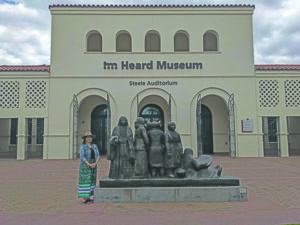Miywasin Moment: Native American museum displays a wealth of historical discovery
By JoLynn Parenteau on March 9, 2022.
SUBMITTED PHOTO JOEL COCKS
This bronze sculpture, "Intertribal Greeting", 2003, by artist Doug Hyde of Assiniboin, Nez Perce and Ojibwe heritage greets visitors of the Heard Museum in Phoenix, Arizona.
Miywasin Moment is pleased to present Part 1 in a series of Native American history gleaned from reflections on the columnist’s travels.
“We survived all these years, and we intend to survive the rest of time.”
– Tony Reyna, Taos tribe
In the heart of Phoenix, Arizona stands the historic Heard Museum. Founded in 1929, the Heard is recognized for its dedication to the preservation of Native American art, clothing and culture.
There is much to explore from the moment one enters the outdoor courtyards. Lifelike and abstract bronze and stone figures of ancestors and animals nestle among tranquil water features. A sculpted mural depicts a creation story. Storyboards and sculptures of the American Indian Veterans National Memorial honour warriors over the 17th-21st centuries.
Soon enough, the cool indoor galleries draw visitors inside out of the desert heat. A stunning abstract mixed-media cactus installation at the first gallery’s entrance immediately draws attention. A quote from the artist Rosemary Lonewolf “reminds visitors to leave stereotyped preconceptions behind and enter a world where Indigenous people blend the past with the present and firmly establish a limitless future.”
In the American Southwest, Native people remain connected to the lands that have been their homes for centuries. Present-day tribal lands of Arizona number over 30 territories and include the Navajo, Hopi and Apache peoples, and many others. The stories of the people who made the artifacts on display in the Heard galleries are all different and yet, as Native people, they have a shared history and land, and their stories feature common themes.
Curiosities of every variety catch the eye and inspire the imagination. Calf-height footwear made of turkey feathers and yucca leaf originating from A.D. 500-1300 would have provided warmth in Northern Arizona winters. Delicate pottery painted with geometric patterns was used to carry water, cook food, store goods and hold the spirits of those since gone. Over 400 Hopi Katsina figurines made of cottonwood roots wear many fantastical masks, posing as spirits. Intricately feathered and beaded headdresses, regalia, and brightly coloured woven clothing and tapestries have stood the test of time. A hollowed out painted gourd depicts a hummingbird and bright florals significant to the Yaqui spiritual world.
A calendar stick made out of cactus rib is intricately carved with mysterious symbols. “A calendar stick is like a diary, a way of recording your life in a form that you can share with other people. Each stick is personal, so each one is decorated and presented in the way the person feels that they want it to be presented,” explains Akimel O’otham tribe artist Timothy Terry Jr. of the Gila River Indian Community. He created this replica in 2004 from an older one that recalls the years 1856-1859. A stylized meteor is recorded from 1859. “We were very fortunate that we had three elderly gentlemen keep a record of their sticks on a piece of paper, and it was shared with the community,” writes Terry.
The Apache settled in this desert region in the 15th and 16th centuries. A set of rudimentary rawhide playing cards, circa 1885, are displayed, based on Spanish cards the Apache obtained in the 1600s. There are four suits: Clubs, cups, coins and swords, depicted with faceless figures. A second modern set, circa 2000, are similar to cards still played with by elders today.
A contemporary art gallery features acrylics, oils and watercolours portraying buffalo and dancers, galloping horses, a breathtaking grand desert vista and even a curious tuxedoed coyote playing a flaming piano.
Textiles and artifacts from wedding traditions and war, art, agriculture and early industry are all on hand at the Heard Museum. One could spend many engaging afternoons exploring it all.
Museum-goers can complement a break in the middle of a visit with a prickly pear lemonade from the Courtyard Café which offers Southwest-influenced cuisine and salads aptly named the Dreamcatcher and Sonoran Sunset.
The gift shop is a gallery in itself. Sculptures and paintings worth thousands are available for private collections. Tapestries and textiles in every colour, in rugged and fine weave, are for sale. Simple beaded hoop earrings are the most affordable item at $22USD but one leaves longing for a silver and turquoise bolo tie that’s out of reach on a shoestring budget.
The Heard Museum’s festivals and events attract over 40,000 visitors annually, an impressive feat as it approaches 100 years of celebrating Native American art and storytelling.
JoLynn Parenteau is a Métis writer out of Miywasin Friendship Centre. Column feedback can be sent to
jolynn.parenteau@gmail.com .
17
-16
 SUBMITTED PHOTO JOEL COCKS
This bronze sculpture, "Intertribal Greeting", 2003, by artist Doug Hyde of Assiniboin, Nez Perce and Ojibwe heritage greets visitors of the Heard Museum in Phoenix, Arizona.
SUBMITTED PHOTO JOEL COCKS
This bronze sculpture, "Intertribal Greeting", 2003, by artist Doug Hyde of Assiniboin, Nez Perce and Ojibwe heritage greets visitors of the Heard Museum in Phoenix, Arizona.

